Newspaper Death Watch

Bad News For Media People: The media industry was racked by a record 30,711 job cuts in 2020 - a stunning increase of 201% from the year earlier when 10,201 jobs were lost.
The figures which came from outplacement firm Challenger, Gray & Christmas, included jobs data from the news industry, advertising, television and movie production.
Don Surber noted, "In cheerleading lockdowns, newspapers sentenced their local advertisers to doom. Amazon replaced the local store. Netflix replaced the movie theater. Walmart replaced the supermarket. And chain franchises replaced the local restaurant, which valiantly tried to do takeout for the first time. No local merchants meant no local ads which meant unloading staff." (posted 1/13/21, permalink)
 Newspaper Death Watch - 2019 Edition: Once upon a time, the newspaper and magazine industry was one of the largest employers in America. No more. New research shows that over 2,000 newspapers have closed in the last 15 years. The newspaper industry has continued its relentless downward spiral, which started with the advent of the internet and accelerated during the Great Recession. The pace of the decline has not slowed. New research shows that over 2,000 newspapers have closed since 2004, a staggering figure given that the industry was once among the largest employers in America. I'd hate to have America depend on network news and a tiny number of establishment newspapers. But that's where we're going. Newspaper Death Watch - 2019 Edition: Once upon a time, the newspaper and magazine industry was one of the largest employers in America. No more. New research shows that over 2,000 newspapers have closed in the last 15 years. The newspaper industry has continued its relentless downward spiral, which started with the advent of the internet and accelerated during the Great Recession. The pace of the decline has not slowed. New research shows that over 2,000 newspapers have closed since 2004, a staggering figure given that the industry was once among the largest employers in America. I'd hate to have America depend on network news and a tiny number of establishment newspapers. But that's where we're going.
Penny Abernathy, the Knight Chair in Journalism and Digital Media Economics at the University of North Carolina at Chapel Hill School of Media and Journalism, said "It appears at this stage that we've lost approximately 2,100 papers, all but 70 of which are weeklies, since 2004." The industry implosion has left almost half of the counties in America (1,449) with only one newspaper, which is usually a weekly. As of the most recent count, 171 counties do not have a paper at all. Newspaper circulation is at the lowest level since 1940.
"The number of papers in America is currently about 7,000, but as revenue at most of them declines, that number is bound to shrink further. Some newspapers already are close to shuttering. Publishers, both individual owners and chains, have resorted to the equivalent of life support. A recent example is that the Pittsburgh Post-Gazette, which was started 233 years ago, will cut the number of days it is printed from five to three." Our weekly free newspaper has shrunk noticeably in size, pages and content. (posted 8/20/19, permalink)
 Falling Faster Than A Tall Spruce Near A Windy Cliff: Circulation of daily newspapers has dropped to a 77-year low, signaling an end to print and a shift to all-digital delivery, according to a new industry review. The Pew Research Center said that circulation has reached a new low of 34.6 million, six million less than papers sold in 1940. Falling Faster Than A Tall Spruce Near A Windy Cliff: Circulation of daily newspapers has dropped to a 77-year low, signaling an end to print and a shift to all-digital delivery, according to a new industry review. The Pew Research Center said that circulation has reached a new low of 34.6 million, six million less than papers sold in 1940.
Pew noted: "The estimated total U.S. daily newspaper circulation (print and digital combined) in 2016 was 35 million for weekday and 38 million for Sunday, both of which fell 8% over the previous year. Declines were highest in print circulation: Weekday print circulation decreased 10% and Sunday circulation decreased 9%."
Don Surber added that online versions of newspapers are doing poorly, noting that monthly unique visitor counts for all newspapers in America is less than Matt Drudge gets in a day. "More importantly, that combined online circulation is one-fifth what Craigslist gets each month."
"What killed newspapers was Craigslist. This online service was cheaper and better than the classified ads in the newspapers. Craig Newmark in 1995 started Craigslist and less than 20 years later he had swiped two-thirds of the classified ads of all the newspapers. Craigslist had 59 million unique visitors in March versus 11,734,546 for all the newspapers in America."
I would add that, 20 years ago, most display advertising was for homes and vehicles. Today, people looking for a home or car don't bother looking at newspapers; they search online.
When we bought our grandson a lightly-used Mazda3 for his 2015 graduation, we searched cargurus.com to find a suitable one. (posted 6/28/17, permalink)
Fake News Of A Different Sort: David Snowball of the Mutual Fund Observer has warned about "a scam that a number of newspapers have resorted to. In order to extract extra money from people who have already paid for, say, a year's subscription, the newspapers are cutting weeks off the end of your subscription.
 In my case, the Quad City Times sent a subscription rate increase notice that contained the cryptic warning, "this increase may accelerate the end of your current subscription period." That struck me as impossible, since I paid for 52 weeks in advance. When I called the Times they confirmed their plan to cut six weeks off the end of my subscription; rather than ending in late September, my subscription would end in early August. I inquired about whether the phrase "breach of contract" was new to them; they offered 52 weeks for a set amount, I paid the amount, they owe me 52 weeks. Period. In my case, the Quad City Times sent a subscription rate increase notice that contained the cryptic warning, "this increase may accelerate the end of your current subscription period." That struck me as impossible, since I paid for 52 weeks in advance. When I called the Times they confirmed their plan to cut six weeks off the end of my subscription; rather than ending in late September, my subscription would end in early August. I inquired about whether the phrase "breach of contract" was new to them; they offered 52 weeks for a set amount, I paid the amount, they owe me 52 weeks. Period.
The operator offered to extend my subscription by four weeks in early September, "so you're subscription started in September and now it will end in September so that works, right?" No, it doesn't. I reminded her that I paid for 52 weeks, not 46 nor 50. Next she offered a $25 gift card. And again, no. The contract said 52 weeks, I expect 52 weeks. She's promised to have a supervisor call. None has. The QCT is published by Lee Enterprises, which publishes about 100 newspapers in the Midwest and West."
One of David's colleagues "reported a similar problem with her mom's local paper, the Times Herald Record (Middletown, NY). The paper is now collecting its monthly charge every three weeks. Why? Because they've designated some of their issues as 'premium editions' and those cost you extra, which they accommodate by shortening your subscription period. The THR is part of the Local Media Group, which publishes two dozen newspapers."
This deceitful con job from a dying medium simply confirms that many newspapers treat loyal subscribers with contempt, while sucking up to their dwindling advertiser base. I haven't subscribed to a newspaper since early 2008 but, if you're still getting some of your news from dead trees, you may want to check your bill carefully. (posted 3/22/17, permalink)
Print Woes: Mark J. Perry wrote, "Newspaper jobs continue the steep decline that started back in the early 1990s and accelerated about ten years ago. Compared to the peak of nearly 458,000 newspaper jobs in 1991, the industry has shed more than a quarter-million jobs and employment was down to 180,100 jobs in July, well below even the 1947 level. Expect the "creative destruction" to continue."
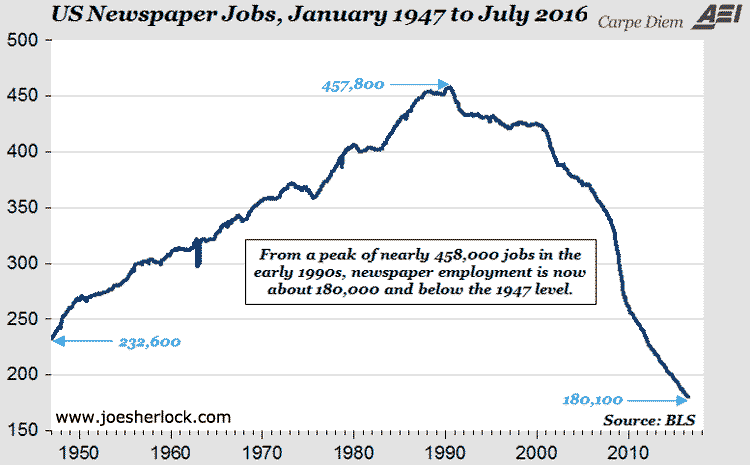
It's hard to blame these job losses on offshoring. The culprits are technology and changing demographics. Technology means digital forms of information distribution as well as technological improvements in the printing industry.
Then there's the age thing. Some geezers my age still subscribe to daily newspapers. Others, like me, who grew up with the daily newspaper now get our news from the web. Before the internet, my children who are Gen Xers, got their news from drive-time radio. They never subscribed to newspapers. These days they use mobile devices. As does my grandson.
An article in The Wall Street Journal noted, "Global spending on newspaper print ads is expected to decline 8.7% to $52.6 billion in 2016, according to estimates from GroupM, the ad-buying firm owned by WPP PLC. That would be the biggest drop since the recession, when world-wide spending plummeted 13.7% in 2009."
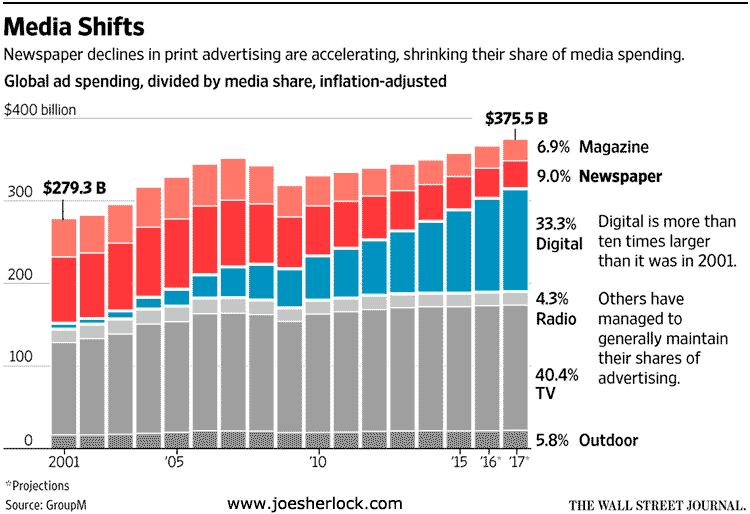
Billboard, television and radio ad revenues have been relatively unaffected, while newspaper and magazine revenue have suffered as they have been replaced by digital media buys. Digital now represents one-third of all ad spending.
"Newspapers have been in a race against time to grow their digital revenues to make up for the collapse of print advertising. They have made strides, but face challenges on that front, including the dominance of Facebook and Google in the digital market and difficulty making money on mobile products."
"During the past decade, marketers have fled newspapers for a variety of reasons, including declining circulation, aging readership and the need to fund their digital initiatives."
The New York Times' third-quarter earnings fell sharply as print advertising dropped 19%, "the latest newspaper publisher to signal that spending on ads is drying up even further."
The Times said its overall advertising revenue decreased 7.7% in the third quarter, and the company expects a similar decline for the fourth quarter. Digital advertising sales, meanwhile, grew 21%, mostly on growth in its mobile platform. Circulation revenue rose 3% as the company's digital subscription push and an increase in newspaper home-delivery prices offset a decline in newspaper sales.
"Although prices vary widely, the average CPM, which is the cost for reaching a thousand people, for a full-page ad in a national newspaper is roughly $100. Meanwhile, the average CPM for a broadcast TV ad in prime time that reaches 25- to 54-year-olds is roughly $37, according to several ad buyers."
"That means that when an advertiser weighs the performance of print ads against their cost, print doesn't appear as efficient as other media when ranking return on investment," said David Murphy, chief executive officer of Novus Media, an ad-buying firm owned by ad giant Omnicom Group, Inc. (posted 11/7/16, permalink)
Terminal Condition: Over the past 11 years, I've chronicled the decline of the newspaper industry as well as other print media here. Over the last few years, newspaper circulation has declined by 22-40%, depending on which newspaper one measures.
Recently Paul Bedard of the Washington Examiner has provided additional evidence, writing, "The Bureau of Labor Statistics has been charting the demise of newspapers, and its latest numbers reveal what many in the industry have been witnessing. Newspaper employment, as of March, had dropped to 183,200, compared with 197,800 working in 'Internet publishing and broadcasting'."
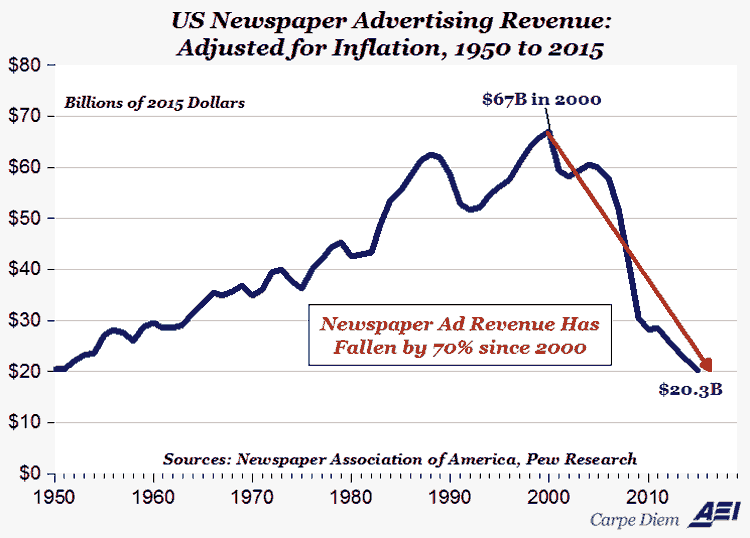
"An analysis by the Nieman Journalism Lab charts the beginning of the end of newspapers to the dawn of the Internet Age in 1990. That year, newspaper employment hit a peak of 457,800. It is down 60%.
Some print publications are dumping paper and going online while keeping many of their reporters, editors and administrative staff."
The analysis concluded, "It's safe to assume that newspaper jobs will continue to evaporate. Most small and mid-sized metro papers are struggling to find new revenue as print advertising and circulation decline and online advertising fails to make up the difference." (posted 7/11/16, permalink)
 Still Good For Wrapping Fish, Though: In a two-and-one-half year period, newspaper circulation has declined by 22-40%, depending on the newspaper. Gerard Van der Leun noted, "There remain only two print newspapers in the entire country (the Wall Street Journal and New York Times) that sell more than a half million copies per average weekday, only six that sell a quarter of a million copies and probably [correction: not many more than] 22 that sell more than 100,000." Still Good For Wrapping Fish, Though: In a two-and-one-half year period, newspaper circulation has declined by 22-40%, depending on the newspaper. Gerard Van der Leun noted, "There remain only two print newspapers in the entire country (the Wall Street Journal and New York Times) that sell more than a half million copies per average weekday, only six that sell a quarter of a million copies and probably [correction: not many more than] 22 that sell more than 100,000."
The Columbian is the only paid newspaper serving Clark County Washington. The Columbian's paid subscribers totaled 27,601 in 2013 - less than 6% of 450,000 Clark County's residents. We canceled our subscription in early 2008. As a comparison, back in 1950, 123% of households subscribed to a newspaper. (One household in five subscribed to more than one paper.)
Today, only old people still read newspapers ... and they're dying off. Soon, most newspapers will be dead too. (posted 3/9/16, permalink)
A Dying Medium: Newspaper print advertising revenues of just $16.4 billion in 2014 fell to the lowest level of print advertising since the Newspaper Association of America started tracking industry data in 1950. In constant 2014 dollars, advertising revenues last year were $3.6 billion (and 18%) below the $20 billion spent in 1950, 65 years ago.
Newspaper print advertising revenues decreased more than 57% in just the last six years, from $38.15 billion in 2008 to only $16.4 billion last year; and by more than 75% from the $67 billion peak in 2000. (posted 5/22/15, permalink)
Paper Of Record: The Clark County Board of Commissioners has voted to make rural weekly newspaper, The Reflector, the official paper of record for the county beginning July 1, 2014. About $44,000 worth of county legal notices will appear primarily in The Reflector, which is based in Battle Ground, WA.
This is a big loss for The Columbian, the Vancouver-based daily newspaper which, until now, has had pretty much a monopoly on this business. The Reflector's bid to the county included rates nearly half of The Columbian's bid. The Reflector is delivered free to 26,826 homes, about the same number of The Columbian's paid subscribers (27,601). Clark County population is almost 450,000.
County commissioner David Madore said a key factor in his vote to award the bid to The Reflector was ... (more >>>)
Can The Oregonian Get Any Smaller? The Portland newspaper's publisher, N. Christian Anderson III, announced this week that, starting in April, the entire daily paper will print on pages 15 inches tall by 11 inches wide, small even by tabloid standards.
Soon it will only be useful for wrapping small fish. (posted 1/23/14, permalink)
More Print Woes: Newspapers aren't the only print publications in turmoil. Model Auto Review, a British model and toy car magazine, has ceased print publication. Starting soon, it will become an online-only publication.

Founder Rod Ward provided details. "Back in 1982, when MAR started 10% of our sales went to subscribers, the other 90% to stockists (retailers/newsstands). Now, although the number of MAR subscribers has fallen by about half in three decades, the quantity of magazines bought by stockists has dropped by more than 99%. ... You won't be surprised to learn that it is not now commercially viable to print less than 6% of the quantity of copies we used to sell."
A 94% drop in print sales, most of it in the last decade, is alarmingly large. But this is one example of the revolution going on in the magazine world. Newsweek ended its print edition in 2012 and is now strictly found online. In 2008, Time discontinued publishing a Canadian advertiser edition. At Time magazine's zenith, it could reach more than 20 million people around the world each week. These days, circulation is around 3 million. Bloomberg bought BusinessWeek at a fire-sale price in 2009. Forbes magazine is now up for sale. Road & Track is rumored to be on the ropes.
Whole Living, Martha Stewart's health magazine, shut down earlier this year. Reinventing Beauty also ceased print operations in 2013, as did Everyday Food, Celebrity Hairstyles, PC World, Skateboarder, Bird Talk, Nintendo Power, Caribbean Travel and Life, Vibe and Garden Design.
The Model Auto Review story represents a microcosm of the print magazine business in general and reflects how problems are magnified in the specialty/hobby magazine segment.
In 2003, O-Gauge Railroading was a 154-page magazine. The latest issue has only 90 pages, mostly because of fewer advertisers. Subscription rates on a price-per-page basis have doubled. Its last reported circulation was in the 15-20,000 range.
In 2009, Interlink, the parent of Motor Trend as well as Hot Rod and Automobile filed for bankruptcy, citing a "decline in decline in advertising spending, especially among automotive companies, as well as rising costs for raw materials." In the U.S., most car buff mags saw sales peak in the late 1980s and have attempted to maintain circulation levels by offering deeply-discounted subscriptions. With declining subscription revenue, auto mags have become more advertiser-dependent than ever. This has made them less critical and more sycophantic in tone. And, in the internet age, their news, spy shots and road tests are stale by the time they reach one's mailbox.
It is difficult to make a business case for any print media these days. (posted 12/5/13, permalink)
How Bad Is It? The newspaper advertising free fall that started in about 2003 "has generated so much negative publicity when the quarterly statistics were released that the Newspaper Association of America has stopped reporting quarterly data this year."
Professor Mark Perry believes that "total print newspaper advertising revenue will decline this year to just under $17 billion, which would be a $2.2 billion drop in revenues from last year."
In 2000, newspaper ad revenue was almost $66 billion. Now you know why your newspaper is so thin these days. (posted 10/8/13, permalink)
 Three Day Per Week Fish Wrap: The Oregonian, the largest daily newspaper in Oregon, will only be printed for home delivery three days per week: Wednesday, Friday and Sunday beginning October 1st. Three Day Per Week Fish Wrap: The Oregonian, the largest daily newspaper in Oregon, will only be printed for home delivery three days per week: Wednesday, Friday and Sunday beginning October 1st.
The Oregonian retains its title as The Worst Large City Newspaper I've ever experienced. It has held said title for 35 years. Even in 1978, when we first moved to Oregon, the Oregonian was mostly a wire service paste-up job, with vacuous local writing and near-zero investigative journalism. By comparison, other big city newspapers tried harder and produced an admirable product, even if one didn't agree with their editorial positions.
Willamette Week, the alternative Portland tabloid weekly that still does actual reporting as opposed to clipping and pasting AP stories, predicted the Oregonian's latest move downhill almost a year ago. (posted 6/28/13, permalink)
 The Perfect Storm: The Chicago Sun-Times has laid off its entire photography staff and plans to use freelance photographers and reporters to shoot photos and video to replace the 28 full-time staffers. The Perfect Storm: The Chicago Sun-Times has laid off its entire photography staff and plans to use freelance photographers and reporters to shoot photos and video to replace the 28 full-time staffers.
This is just another result of the perfect storm that's drowning newspapers:
• Advertising peaked in 2000 and has been in sharp decline ever since. Internet advertising has now passed newspaper advertising in outlays.
Display ads have tanked due to increased competition from internet ads, well-designed websites, social media marketing and a proliferation of attractively-priced radio and television ad packages.
Classified ads have virtually disappeared due to Craigslist, eBay and the like.
• Circulation has been in decline for many years (it peaked in the mid-1980s), but lately, the drop has been accelerating. Most people under 50 are neither subscribers nor readers of print media.
A spoof headline from The Onion says it all: 'Majority Of Newspapers Now Purchased By Kidnappers To Prove Date'.
• Technology has changed the photography business. No longer is it necessary to have finely-honed tech skills and expensive and elaborate cameras to produce good photos. Just use a point-and-shoot digital camera - or even a smart phone in a pinch - and fix any flaws in Photoshop.
Nowadays, almost everyone is a 'photographer'.
As print struggles to survive, expect to see similar layoffs at other old-line newspapers. (posted 5/31/13, permalink)
I Won't Miss It: According to a story in Willamette Week, the alternative Portland tabloid weekly that still does actual reporting as opposed to clipping and pasting AP stories, the Oregonian is facing a final deadline as a daily newspaper.
The WW writer predicts that the Oregonian will soon publish a print version only three days a week, fire nearly half the staff and leave the remaining reporters and editors to focus on publishing news on its deplorable, counterintuitive website.
That doesn't bother me. The Oregonian remains the worst large city newspaper I've ever experienced. When we relocated to a small town in Oregon almost 35 years ago, we were first exposed to Portland's "big city paper." And were quite disappointed.
Even in 1978, the Oregonian was mostly a wire service paste-up job, with vacuous local writing and near-zero investigative journalism. (posted 8/13/12, permalink)
 I Hate The Oregonian More Than Doonesbury: Cartoonist Garry Trudeau is nothing but a rich socialist who knows how to draw. Many of his 'comic' strips are blatant lefty political statements. I Hate The Oregonian More Than Doonesbury: Cartoonist Garry Trudeau is nothing but a rich socialist who knows how to draw. Many of his 'comic' strips are blatant lefty political statements.
I saw one of his recent strips (poking fun at Bain Capital and Mitt Romney) in the Sunday Oregonian - Portland's dreadful newspaper - in the comics section.
I accept that Trudeau is über-liberal. I accept that fewer and fewer items in the 'funny pages' are actually funny. What I don't accept is that this liberal newspaper would put political cartoons in the comics section rather than on the editorial page where they rightfully belong.
Maybe it's because they want to indoctrinate the next generation. Except that the next generation doesn't read newspapers. Nor do their parents, which is why newspapers are dying.
For me, the Oregonian can't die soon enough. (posted 6/29/12, permalink)
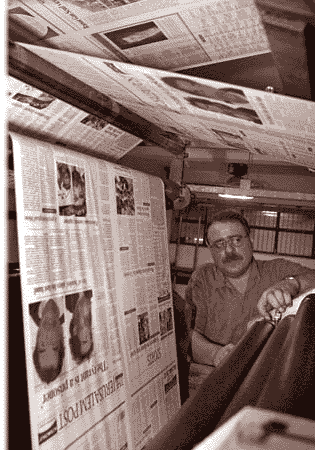 Dead Tree Report: The Financial Times has noted, "In recent weeks, LinkedIn, the networking website, and the Council of Economic Advisers have reported that the press is "America's fastest-shrinking industry," measured by jobs lost; the Newspaper Association of America has shown that advertising sales have halved since 2005 and are now at 1984's level; and the Pew Research Center has found that for every digital ad dollar they earned, they lost $7 in print ads." Dead Tree Report: The Financial Times has noted, "In recent weeks, LinkedIn, the networking website, and the Council of Economic Advisers have reported that the press is "America's fastest-shrinking industry," measured by jobs lost; the Newspaper Association of America has shown that advertising sales have halved since 2005 and are now at 1984's level; and the Pew Research Center has found that for every digital ad dollar they earned, they lost $7 in print ads."
Digital ads? When was the last time you clicked on an ad posted on a news site? I can't remember either. Newspapers? We now only get one print version - the free local weekly.
We dropped our subscription to the Columbian - it serves Vancouver and Clark County, WA - in early 2008.
As to the Portland metro paper, I hadn't looked at the Oregonian in years until recently (got a free copy) but I can now conclude that it remains the worst large city newspaper I've experienced. A waste of two bucks.
When we relocated to a small town in Oregon almost 35 years ago, we were first exposed to Portland's "big city paper." And were disappointed. Even in 1978, the Oregonian was mostly a wire service paste-up job, with vacuous local writing and far less investigative reporting than Willamette Week, Portland's free left-leaning tabloid alternative paper.
In 2012, its the same story - the Oregonian's lack of insightful local stories, lame sports coverage, poor writing, stale news, shoddy reporting and a lousy selection of comics. And a political agenda-driven liberal slant which is unbelievable - even for a lefty town like Portland. Its declining readership is proof that readers vote with their pocketbooks. And their feet.
Ironically, a reporter from the Oregonian contacted me a few weeks ago and wanted to meet me because he was doing a story about "local blogs." I thought about it and asked myself, "How will this benefit me?" I couldn't come up with an answer, so I declined the interview.
As media from television to billboards bounce back from the recession, newsprint is being left behind. Zenith Optimedia this week predicted that internet advertising would pass newspaper advertising next year around the world – but "in the U.S., where internet penetration is high and newspaper audiences are shrinking, digital will overtake newspapers' and magazines' combined ad sales this year."
Matt Welch has provided an apt analogy as he wrote about the decline of old-media as interpreted by old media: "Imagine for a moment that the hurly-burly history of American retail was chronicled not by reporters and academics but by life-long employees of A&P, a largely forgotten supermarket chain that enjoyed a 75 percent market share as recently as the 1950s. How do you suppose an A&P Organization Man might portray the rise of discount super-retailer Wal-Mart, or organic foods-popularizer Whole Foods, let alone such newfangled Internet ventures as Peapod.com? Life looks a hell of a lot different from the perspective of a dinosaur slowly leaking power than it does to a fickle consumer happily gobbling up innovation wherever it shoots up."
There are so many ways to get news these days and newspapers are down near the bottom of my list. Probably everyone else's too. (posted 4/23/12, permalink)
Papers Sold ... Again: The parent company of The Inquirer, Philadelphia Daily News and Philly.com has been sold to group of local investors for $55 million with an additional $10 million in working capital for operations.
The deal represents the fourth ownership change in less than six years. Once owned by Knight-Ridder, then McClatchy, the papers went private but went bankrupt three years later.
Like much of the newspaper industry, Philadelphia Media Network has been struggling financially, with declining advertising revenues and smaller circulation bases than a decade ago. A recent report by the Pew Research Center said advertising revenues industrywide decreased 7.3% in 2011, to $23.9 billion. Ad revenues peaked at $48.7 billion in 2000 and have been sliding down ever since. (posted 4/2/12, permalink)
Way To Go: Bob Caldwell, 63, editor of the stuffy, preachy and liberal Oregonian editorial pages, suffered a fatal heart attack after having sex with a 23 year-old woman - a student at Portland Community College. He had "provided her cash for books and other things for school in exchange for sex acts at her apartment."
I'm kinda jealous. I too had a heart attack at 63 but it happened when I was walking down the driveway to pick up the morning paper - not the Oregonian, by the way. I guess I lead a dull life. Ho-hum.
At first, the Oregonian failed to report the tawdry circumstances in which ol' Bob left this world - but mentioned that he "was known all over the building for his big smile and a bigger laugh." No wonder.
Caldwell is survived by his wife and three daughters. (posted 3/14/12, permalink)
Newspaper Ad Revenues Have Dropped Off The Proverbial Cliff: The stagnation in newspaper ad revenues over the last 60 years is disturbing, but the sharp decline in recent years is absolutely stunning. The trend is not good.
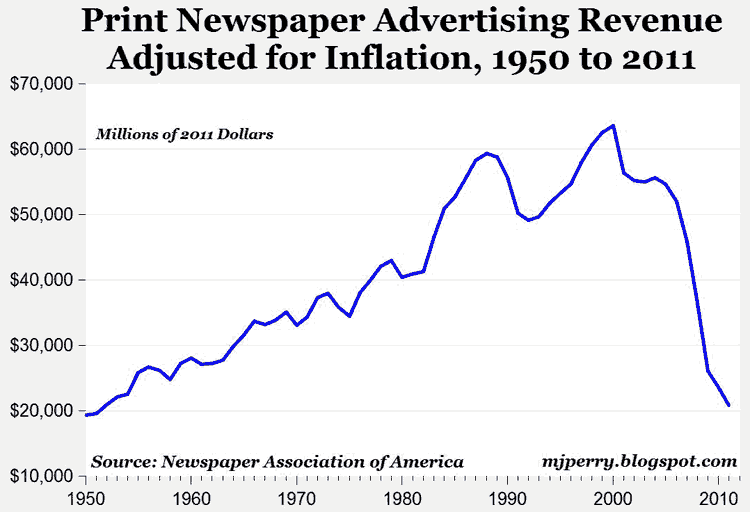
Economics prof Dr. Mark J. Perry has observed, "It took 50 years to go from about $20 billion in annual newspaper ad revenue in 1950 (adjusted for inflation) to $63.5 billion in 2000, and then only 11 years to go from $63.5 billion back to about $20 billion in 2011."
This is another example of capitalism's creative destruction, courtesy of new technology: the internet. (posted 3/2/12, permalink)
Pulp Shrinkage: Last Sunday, my wife purchased a newspaper. The Sunday edition of the Columbian now costs $2.00.
I was appalled at how much the classified - aka: Big Moneymaking Section - had shrunk. There were less than two pages of classified and display real estate ads. Less than a page of employment ads.
This newspaper serves a population of almost 450,000.
No wonder newspapers are losing money. (posted 4/20/11, permalink)
Old News: When we canceled our subscription to the Vancouver (WA) Columbian almost three years ago, we got an unexpected surprise: free weekly delivery (via standard mail) of an emaciated version of the Columbian. To be sure, it was mostly ads and supermarket inserts and the 'news' was a week old but it was free.
The paper carried the title 'Your Week'. I told my wife that, based on timeliness, it should have been named 'Last Week'.
Recently, a new version arrived at our mailbox. The number of pages has increased a little and the Columbian is calling its latest effort 'North County News', with the obligatory snowy Mt. St. Helens on the masthead.
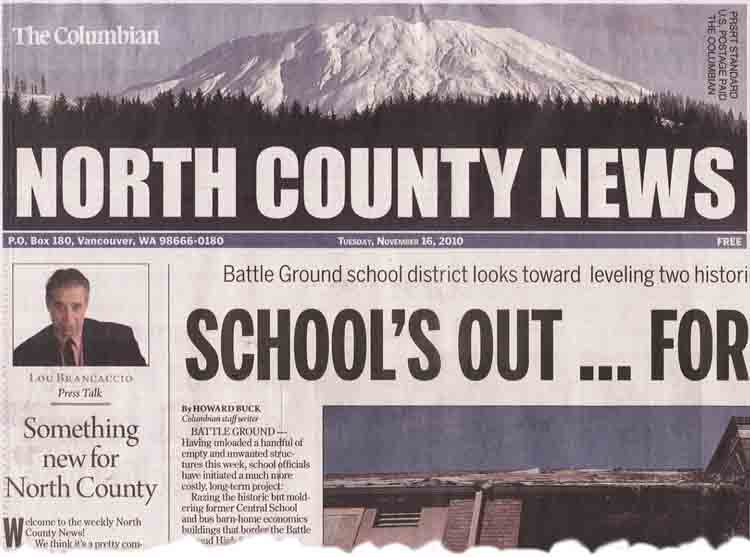
Apparently, the big deal is that the news items are now exclusively from northern Clark County. But they're about two weeks old. Which makes this paper much more stale than The Reflector, a free weekly delivered by carrier to households in the same area. 2013 weekly circulation is just over 28,000. Over that last two months, The Reflector has added to its news staff and has added a business page and more photos. Ads seem to be up, too.
In a welcoming sidebar on the front page of North County News, Columbian editor Lou Brancaccio acknowledges that "we know you can get news of north county from other places. And I'm sure it's good."
Actually, Lou, the news provided by The Reflector is fresher, more comprehensive and there's more of it. Including local events, obituaries and in-depth reporting. And the paper has a lot more pages than yours.
North County News seems to be a half-assed effort - ad material topped with a thin veneer of recycled news, which has already passed its sell-by date.
I wonder ... what was the Columbian thinking (drinking? smoking?) when they came up with this lame idea? (posted 11/24/10, permalink)
Death Spiral: Audit Bureau of Circulations data show that average daily newspaper circulation fell 5% in the six months that ended Sept. 30, compared with the same period a year earlier.
Of the 25 biggest newspapers by circulation, only The Wall Street Journal and The Dallas Morning News posted weekday gains. (posted 10/27/10, permalink)
Big Change: After 100 years of local ownership, The Reflector has been sold to a company out of Centralia, WA. The Battle Ground newspaper has been delivered free of charge to 26,500 households in north Clark County every week for longer than I can remember. Marvin Case is the owner; he reportedly purchased the paper for about $100,000 in 1980. This year, he became its longest-tenured publisher.
In my opinion, The Rejector - as it is fondly nicknamed by locals, is the best newspaper in the area. It is informative and contains concise, locally-produced articles worthy of a much larger newspaper. It is apparently the best-managed newspaper in Clark County; it has been consistently profitable, even during recessions - unlike the much larger Columbian which went bankrupt last year.
I hope the new owners don't wreck The Reflector. (posted 6/23/10, permalink)
Hard-Drinking Newsman: The editorial page editor at the Oregonian newspaper was arrested for drunk driving, after backing his pickup truck into another vehicle while trying to park near a strip club.
Robert Caldwell failed three field sobriety tests and was booked into jail at the Multnomah County Detention Center after blowing 0.10% on a blood-alcohol test. The legal limit is 0.08%. Caldwell claimed he only had a couple of drinks with dinner at Ruth’s Chris Steak House downtown.
The Oregonian has not reported this news but alternative paper Willamette Week has the 411. This helps explain why the mostly-AP-clipping-service Oregonian always did such sloppy reporting ... as if it were assembled by a bunch of drunks. (posted 5/28/10, permalink)
Plummeting Pulp: The latest six-month Audit Bureau of Circulation figures showed a drop of 8.74% in average daily circulation for 602 newspapers, as publishers battle declining print advertising revenue, eroding circulation and the migration of readers to free news on the web.
Among the 25 largest papers, the San Francisco Chronicle and Dallas Morning News suffered the most, losing 22.6% and 21.4% in weekday circulation. USA Today, which has the second largest circulation and is the official newspaper for mid-priced hotels across Our Great Land, declined 13.6% to 1.83 million.
The Los Angeles Times shed 14.7% of its paid readers, while The Washington Post was down 13.1%. Tony Soprano's favorite paper, The Star-Ledger, dropped by 17.8%. Surprisingly, the Oregonian declined by only 1.8%.
Newspaper circulation has been in decline for many years, but accelerated in 2007 and has fallen even more rapidly during the recession. (posted 4/28/10, permalink)
Bird Cage Liner: It is well-known that the historic newspaper business model - charge for ads, charge subscribers - doesn't work anymore. People under 55 get their news from drive-time radio and the internet. The subscriber base has been shrinking for over 20 years.
Bad economic times have now forced advertisers to carefully examine the effectiveness of their limited ad budgets and they're abandoning traditional newspapers for other, more effective venues.
Affiliated Media Inc., which owns television and radio broadcasters as well as 54 daily newspapers and more than 100 non-dailies, is filing for bankruptcy.
Its stable of papers includes the Denver Post, Detroit News, Salt Lake Tribune, San Jose Mercury News, Los Angeles Daily News, Long Beach Press-Telegram, Torrance Daily Breeze, Pasadena Star-News, Monterey County Herald, Redwood Times, St. Paul Pioneer Press, Charleston Daily Mail and El Paso Times.
"About 80% of the firm's revenue is generated from advertising sales, which continue to be affected by the recession." Falling circulation was also cited as a factor.
Morris Publishing Group also plans to file bankruptcy. Morris publishes 13 daily newspapers including the Augusta Chronicle, Savannah Morning News and Florida Times-Union of Jacksonville. It also has more than 60 non-daily newspapers and magazines.
Since 2005, the industry's annual ad sales have dropped by more than $20 billion, a decline of about 40%, based on figures from the Newspaper Association of America.
While the severe recession has exacerbated the industry's problems, it is questionable whether many of these lost advertisers will return as the economy recovers. (posted 1/18/10, permalink)
Fish Wrap: Last week, my wife picked up a copy of the Sunday Oregonian, primarily to check out the retail ad inserts. I hadn't looked at the Oregonian in years but I can now conclude that it remains the worst large city newspaper I've experienced. A waste of two bucks.
When we relocated to a small town in Oregon thirty-plus years ago, we were first exposed to Portland's big city paper. And were disappointed. Even in 1978, the Oregonian was mostly a wire service paste-up job, with vacuous local writing and far less investigative reporting than Willamette Week, Portland's free left-leaning tabloid alternative paper.
In 2009, its the same story - lack of insightful local stories, lame sports coverage, poor writing, stale news, shoddy reporting and a lousy selection of comics. And a political agenda-driven liberal slant which is unbelievable - even for a lefty town like Portland.
No wonder the Oregonian is dying. (posted 11/23/09, permalink)
Paper Loss: The decline in U.S. newspaper circulation has accelerated as the industry struggles with subscriber defections to the Internet and tumbling ad revenue. New data released by the Audit Bureau of Circulations show that average daily circulation dropped 10.6% in last six months from the same period last year. That was greater than the 7.1% decline six-months previously and the 4.6% drop before that.
The Wall Street Journal has now surpassed USA Today as the top-selling newspaper in the United States. The WSJ was up 0.6% during the period - the only daily newspaper in the top 25 experiencing an increase. USA Today dropped more than 17% to 1.90 million. The New York Times was down 7.3%; the Washington Post fell 6%; the New York Post declined almost 19% - same for the Boston Globe.
The San Francisco Chronicle lost more than a quarter of its daily circulation, down 25.8% to 251,782. The Star-Ledger in Newark, N.J. (once Tony Soprano's favorite morning read), dropped 22.2% to 246,006.
Many newspapers are hoping to bring in money from online editions to make up for falling print circulation and advertising sales. Not happenin'. "Online revenue at most large dailies fell last year. Publicly held chains say that online revenue is now 6% to 12% of total sales, and that is not enough to offset a collapse in their traditional revenue stream."
Over in Portland, the Oregonian's circulation is down 12% from last year. The paper sold an average of 249,163 copies of its Monday through Friday editions. The same day, the Oregonian announced a new publisher at the helm; it was rumored that he was presented with a braided captain's hat with Titanic embroidered on the bill.
ABC reported a daily circulation of 36,347 - a drop of 9% - for the bankrupt Vancouver paper, the Columbian.
What does all this decline and turmoil mean? Simply that the business model is broken. Newspaper revenue streams have traditionally been threefold: subscriptions (in serious decline and with no good prospects in sight - most people under 50 simply don't subscribe), display advertising (falling fast due to increased competition from internet ads, well-designed websites and a proliferation of attractively-priced radio and television ad packages) and classified ads (dropping like a stone due to Craigslist, eBay and the like). Low revenue = low viability. Many newspapers will soon disappear.
I'm just guessing, but I think two kinds of papers will ultimately survive: Big national newspapers like the Wall Street Journal; it's content is unique and original enough (not just AP and Reuters regurgitations) that people will actually pay for it - even online. Another survivor will be the small neighborhood paper - the free weekly ones serving small towns or neighborhoods of large towns. They are full of community news: school board meetings, road repairs, local political scandals, etc. and contain lots of ads from local merchants. (posted 10/30/09, permalink)
Headline Of The Week ... is from The Onion: 'Majority Of Newspapers Now Purchased By Kidnappers To Prove Date'.
Excerpt: "According to a report published this week in American Journalism Review, 93% of all newspaper sales can now be attributed to kidnappers seeking to prove the day's date in filmed ransom demands."
"Although the vast majority of Americans now get their news from the Internet or television, a small but loyal criminal element still purchases newspapers at a steady rate," study author and Columbia journalism professor Linus Ridell said.
"These are sick, sick individuals," Ridell added. "God bless them for saving our industry." (posted 10/26/09, permalink)
Recycled Newspaper: The Columbian, now in Chapter 11, hopes to exit bankruptcy soon. Emphasis on the word 'hope'. The paper will need lots of that ... and luck, too. At its May 1 filing to the bankruptcy court, the company "reported 2007 gross revenue of $33.2 million; 2008 revenue of $29.7 million and $6.13 million in the first four months of this year through April 30."
"What we've experienced is 10 to 15 times worse than anything we anticipated in advertising revenue declines," said publisher Scott Campbell, whose family has owned the newspaper since 1921. "In two years, we've seen a 40 percent ad sales decline. To cut costs, we've gone through three rounds of layoffs, frozen pay, reduced production costs, pared back (newspaper) content and moved out of our new office building back to our old building on West Eighth Street."
"We as an industry are still trying to monetize the Web," he said. "It's still in its infancy." In it's infancy? Jeeez, Scott. I'm not exactly an early adapter and I've had a web presence since mid-1997.
If the Columbian were a business client, my first question would be, "Can you show me some examples of newspaper websites which have a successful revenue stream?" In other words, who's doing it now and making money? Some online newspaper data can be found here, including the fact that online revenue was only 12.8% of the New York Times' overall sales - despite 15 million unique online visitors per month. (posted 6/19/09, permalink)
Ever-Steepening Slippery Slope: Washington state's Democratic governor Christine Gregoire has approved a tax break for the state's troubled newspaper industry. The new law gives newspaper printers and publishers a 40 percent cut in the state's main business tax. Since most troubled Washington papers enthusiastically endorsed Democratic candidates, this shouldn't come as a surprise.
Soon the government will own both the auto companies and the newspapers. It will be just like the old USSR. Hope you enjoy driving a Moskovitch and reading Pravda. And riding the Amtrak Red Arrow from Moscow to St. Petersburg. (posted 5/15/09, permalink)
Feeling The Pinch: The Columbian, the local Vancouver, WA newspaper, has filed for Chapter 11 bankruptcy. The Columbian owes approximately $17 million to the Bank of America and to a host of unsecured creditors, including Mason Nolan, a former Columbian executive, $179,263; North Pacific Paper Corp. (Norpac, a Joint Venture of Weyerhaeuser and Nippon Paper) of Longview, WA, $95,000; GE Capital Solutions, Torrance, Calif., $84,331, Page Cooperative, a newspaper buying co-op, $30,000 and Inland Empire Paper Co., Spokane, $27,893.
Publisher Scott Campbell woke up one morning and apparently thought he was the next Pinch Sulzberger and that Vancouver was the next Manhattan. He proceeded to construct a glossy new 118,000 square-foot office tower downtown. The Columbian moved its operation to the new building in January 2008. And suddenly realized that what was missing was Pinch's money. Oops. Shortly thereafter, the Columbian moved its staff back to its old, less flashy building in a seedier part of Vancouver.
'Pinch' Campbell said of the bankruptcy, "The Columbian has seen a 40 percent decline in advertising dollars over the past several years, most of this decline in the past year. In response, we have reorganized, particularly over the past year, and we are positioned to come through this bad economy."
I would point out that the Columbian's decline in revenues began well before the recession. In early 2007 (when Southwest Washington's economy was still firing on all cylinders), the paper initiated a "selective job elimination" program. In February 2008, before the Clark County economy seriously nosedived, the Columbian laid off 8% of its workforce.
Since then, the paper has cut its staff (now less than 260 employees) and cut its size without cutting its price, making it a less desirable read for its remaining subscribers. And a less desirable media buy for its remaining advertisers. (posted 5/4/09, permalink)
Paper Chase: The Audit Bureau of Circulations has released newspaper circulation figures for the six months ending March 31, 2009, showing large declines at many newspapers:
New York Post: -20.55%, Atlanta Journal Constitution -19.91%, Newark Star-Ledger: -16.82%, San Francisco Chronicle: -15.72%, NY Daily News: -14.26%, Houston Chronicle: -13.96%, Philadelphia Inquirer: -13.72%, Boston Globe: -13.68%
Meanwhile, in yet another waste of my tax dollars, the Washington State Legislature approved a measure to give the state's struggling newspaper industry a break on the Washington's B&O tax. Under the proposed measure, the business and occupation tax on newspapers would be cut by 40 percent through 2015. What makes newspapers such a special industry? (posted 4/28/09, permalink)
McPaper Misery: USA Today, the country's largest newspaper, has lost 100,000 subscribers just from the slowdown in travel. The slowdown has resulted in a reduction of more than 7% in the number of copies of USA Today distributed through partnerships with hotel chains such as Marriott, which account for more than half of its weekday circulation of 2.3 million. (posted 4/3/09, permalink)
Shredded Paper: The Sun-Times Media Group, owner of the Chicago Sun-Times and dozens of suburban newspapers, has filed for Chapter 11 bankruptcy, making it the fifth newspaper publisher in recent months to seek protection from creditors. The IRS has said Sun-Times Media Group owes up to $608 million in back taxes and penalties.
The Tribune Company, Chicago's other major newspaper owner, filed for bankruptcy in December. (posted 4/2/09, permalink)
Motown Shrinkdown: The Detroit News and the Detroit Free Press are reducing home delivery to the three days a week most popular with advertisers - Thursdays, Fridays and Sundays. Slimmed-down newspapers, sold at regular prices, will be available in news racks and convenience stores the other four days. More than 80 newspapers in the country - in smaller markets - have dropped at least one publication day since last year. (posted 3/30/09, permalink)
All That's Fit ... or That's All That Fits: The Washington Post has eliminated its stand-alone Business Section, combining it with the front section to save on paper costs. Also shrinking or disappearing are stock listings, comics, TV listings and the crossword puzzle. The Post noted that the changes "will allow us to continue providing the features that our readers tell us they most value in the newspaper," possibly referring to absorbency and a size compatible with popular models of bird cages.
Whenever I visit the WP online site, I am greeted with "Hello undefined" instead of the customary greeting other news sites use for unregistered readers: "Welcome, visitor."
In related news, the last print issue of the Seattle Post-Intelligencer was published Tuesday. (posted 3/19/09, permalink)
Batboy Is A Business Genius. Who Knew? Douglas A. McIntyre of 24/7 has written, "In the future, the big daily newspaper and national weekly magazine will not be printed at all. They will exist on the internet, run by much smaller staffs. Hearst, which said it would close its Seattle paper, the Post-Intelligencer, has told some members of its staff that they may be candidates to create an online version of the paper as its print version is shuttered."
The Weekly World News ceased its print publication in 2007 and is available exclusively online. And is apparently doing very well. WWN is the home of Batboy - the half-bat, half-boy superhero, the purveyor of famous tabloid headlines such as 'Aliens Abduct Cheerleaders', 'Blind Mother Given Newborn Chimp' and 'Heaven Photographed By Hubble Telescope' and the proprietary locale for Ed Anger's rants. In the 1980s, the circulation of Weekly World News peaked at 1.2 million per issue. Sales in 2006 were only 83,000 per issue.
Here's a hot headline from this week's issue of WWN: 'Siegfried and Roy Make Cher Disappear'. Excerpt: "When news got around Las Vegas that the magicians had made Cher vanish, her most devoted fans went into an uproar. Dozens of drag queens and Cher impersonators rushed to the theater. Security guards were quickly trampled under stiletto heels in a violent frenzy of wigs and black fishnets. However, the magicians had already left the building.
No charges have been filed yet for Cher's apparent kidnapping. Siegfried and Roy were last seen riding into the sunset on their white tiger, followed closely by a legion of angry drag queens."(posted 3/11/09, permalink)
Fit To Print? Randall O'Toole has written, "There's been a lot of hand-wringing lately about the future of the newspaper industry. ... Without newspapers, "corruption will rise, legislation will more easily be captured by vested interests and voter turnout will fall."
Funny, I've always found that the big-city daily newspapers were the ones doing the most to cover up corruption and protect special-interest groups. Meanwhile, the weekly papers, like Portland's Willamette Week are the ones doing the investigative journalism."
Amen, Randall. While Willamette Week's politics are much to the left of mine, they certainly do excellent investigative work, unlike the AP reprint machine known as the Oregonian. The once-great Portland Tribune becomes more like the Oregonian with each passing week. (posted 3/4/09, permalink)
Three More Dead In Philly: Three longtime community newspapers in Philadelphia were suddenly closed without so much as a word of warning to their readers or employees.
Staffers of the Olney Times, News Gleaner and Northeast Breeze were told all three weekly publications were going to be shut down immediately during an impromptu morning meeting. Owner - the Journal Register Co. of Yardley PA - is $650 million in debt.
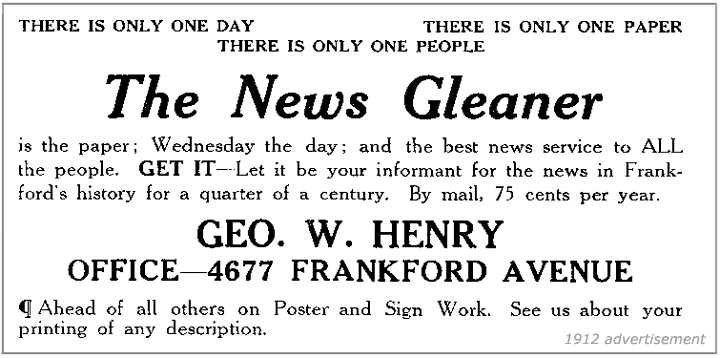
I used to read the then-named Frankford News Gleaner when I was a kid. The Gleaner dates back to 1882.
Thankfully, the Northeast Times (formerly the Mayfair Times - another of my ol' favorites) is owned by a different firm and is still in business. (posted 12/17/08, permalink)
Broken News: The Tribune Co., the Chicago-based media company - whose properties include the LA Times, Los Angeles television station KTLA, Chicago station WGN, the Chicago Cubs baseball franchise, Wrigley Field and the Chicago Tribune, has filed for Chapter 11 bankruptcy protection. The firm owns eight daily newspapers, including the Baltimore Sun, Sun Sentinel (South Florida), Orlando Sentinel, Hartford Courant, Newsday (NY), Morning Call (Allentown, PA) and Daily Press (Newport News, VA), and 23 television stations, including Portland's KRCW (Channel 32, a WB affiliate).
In related news, the New York Times has mortgaged its 52-story mid-Manhattan headquarters in order to cover its cash needs. (posted 12/10/08, permalink)
Local Troubles: The Columbian, Vancouver's newspaper is moving out of its brand spankin' new six-story 118,000-square-foot $30 million downtown structure back to its former and more modest offices a few blocks away. The company must either sell the building, negotiate a new loan with its lender or file Chapter 11 bankruptcy.
An unexpected rise in new building costs, tight credit market and downturn in newspaper advertising revenue business are the roots of the newspaper's present crisis. The Columbian, which has experienced two rounds of layoffs in the past 10 months, employs a total of 270 people.
Meanwhile, on the Other Coast, Moody's Investors Service has said that it may cut its ratings on New York Times Co. into junk territory, citing concerns about continuing revenue declines and risks associated with refinancing its debt.
Moody's said it may cut the New York Times from 'Baa3', the lowest investment grade. Downgrades into junk territory can significantly increase a company’s borrowing costs. (posted 10/24/08, permalink)
Paper Crisis: "If the economy were better, newspapers would be better," said Mort Goldstrom, vice president for advertising at the Newspaper Association of America.
Meanwhile, newspapers nationwide lost more than $130 million last year in auto ad sales. Car ads have gone from 10% of national newspaper ads, to less than 3% in just three years.
But it's not just newspapers. In 2004, about $24 billion was doled out to television, print, and radio ads. Slow sales coupled with cash-strapped automakers and dealerships have cut that number to about $15 billion in 2008.
Magazines are also suffering, losing $72 million in automotive advertising in the first quarter.
Newspapers and magazines are experiencing severe circulation drops as more people get news and information online.
Television viewership is not growing either; more time spent in front of a computer screen translates to lest time spent in front of a television screen.
Ad rates are based on circulation/viewership. When these decline, so do ad revenues.
My question is, "When newspapers are gone, what am I going to use to mask stuff off when I'm spray painting?" (posted 8/14/08, permalink)
Dead Tree Update: During the last six months, newspapers had a record drop in sales - down 3.5% daily and 4.5 for Sunday. The New York Times lost more than 150,000 copies on Sunday. Circulation has fallen a whopping 9.2% over the past half-year. It's still the largest circulation Sunday newspaper, though.
Daily circulation at the Orange County Register plunged 11.9%; the Miami Herald's daily circulation lost more than 11%.
The top daily newspaper is now USA Today, followed by the Wall Street Journal.
As I noted in an earlier posting, we no longer receive a newspaper at this household. (posted 5/7/08, permalink)
I'm Saving Trees! As of yesterday, we no longer receive a daily newspaper. I've been reading newspapers ever since I discovered the comics page 59 years-or-so ago, so this is a fairly drastic event. Now I get all the news I need from the net and paying for a hard copy has become redundant. The comics I want to read are also online - all nine of them. (Real Life Adventures, The Other Coast, Rose Is Rose, Pickles, Sherman's Lagoon, Blondie & Dagwood, Hagar the Horrible, Nancy & Sluggo and Gasoline Alley)
Geez, maybe I'm to blame for The Columbian laying off 8% of its workforce last week. "Faced with a weakened local economy, The Columbian publishing company announced a restructuring that will eliminate about 30 jobs from its 360-person work force." The announcement said that it's due to "a weak economy, particularly in real estate, automotive, and retail advertising." An odd choice of words, since the local economy is doing OK. It's the newspaper's ad revenues that are weak. I suspect that much of that advertising money is now being invested in online websites/ads.
"Over the past year, the company imposed selective job elimination as positions came open, but it was not enough to respond to the economic situation." Aha! So this has been going on for some time then. Now I feel less guilty.
Newspaper readership has been falling steadily for a long time. The former editor of the L.A. Times said that its readership has been in decline since 1991. Other newspapers peaked in circulation 25 years ago. The average user now spends 12 hours per week on the internet. That time has to come from somewhere. I bet many 'net users free up time by eliminating newspaper reading.
A Media Management Center study estimates that by 2010, only 9% of those in their 20s will read a newspaper every day. The average age of a newspaper reader is now 55.
Somewhere, a tree is smiling and saying, "Thank you." (posted 2/27/08, permalink)
In The Future, How Will People Line Their Birdcages? Much has been written about the downward spiral of newspapers. I've also written about it in the past. Here's more:
In 1950 newspapers in the United States had a weekday circulation of 54 million. The circulation figures are roughly the same today, but the number of households has more than doubled. The Los Angeles Times' daily circulation was down 8 percent in a single six-month period in 2006, while the Philadelphia Inquirer was down 7.5 percent and the Boston Globe 6.7 percent.
The Project for Excellence in Journalism issued a report, noting, "In some cities, the numbers alone tell the story. There are roughly half as many reporters covering metropolitan Philadelphia, for instance, as in 1980. The number of newspaper reporters there has fallen from 500 to 220. The pattern at the suburban papers around the city has been similar, though not as extreme. The local TV stations, with the exception of Fox, have cut back on traditional news coverage. The five AM radio stations that used to cover news have been reduced to two. As recently as 1990, the Philadelphia Inquirer had 46 reporters covering the city. Today it has 24. ... Major news stories are going untold."
Ed Herman, professor emeritus at the University of Pennsylvania's Wharton School and an expert not just on the media but on Philadelphia, said the sense of civic connection that should be nurtured by a great newspaper is instead fraying. "Newspapers were once thought to bring communities together. That's not the case anymore. People aren't stupid. They recognize when their local newspaper loses interest in them as anything but consumers of advertisements."
Syndicated columnist Molly Ivins had said that newspapers aren't dying but committing suicide. "What really pisses me off is this most remarkable business plan: Newspaper owners look at one another and say, 'Our rate of return is slipping a bit; let's solve that problem by making our product smaller and less helpful and less interesting.'"
Too many papers are becoming nothing more but a clip-and-paste service, jettisoning local reporters and columnists, in favor of wire services and syndicated columnists. That's why circulation is dropping. The papers have lost their personality ... and appeal. (posted 1/17/07, permalink)
Sliding Toward Irrelevance: Average weekday circulation at U.S. newspapers fell 2.6 percent in the six month-period ending in September, the latest sign of trouble in the newspaper business, an industry group reported. Sunday circulation fell 3.1 percent. The San Francisco Chronicle is down 16.4 percent. Maybe that's punishment for dropping Robert Farago's auto reviews. (posted 11/9/05, permalink)
The Sound Of Pillars Crumbling: Newspaper people across the country have descended into a collective funk over a run of bad news in recent weeks - culminating with announcements of newsroom job cuts in San Francisco, San Jose, New York, Boston and Philadelphia. The future of their business, several young New York Times reporters concluded with dismay that most of their friends don't subscribe to the newspaper.
An industrywide circulation drop of 1.9% for the six months ended in March was one of the biggest in recent times and continued a fairly consistent two-decade decline. Daily newspaper circulation has fallen nearly 9 million from its 1984 peak of 63.3 million, while the U.S. population has grown by about 58 million. The country lost 306 daily papers, 17% of the total, between 1960 and last year.
A dramatic flight of advertising has followed the circulation losses - with classified ad revenue dropping 15% from 2000 to 2004 - dragged down largely by an almost 50% decline in employment advertising.
Knight-Ridder - the second-largest newspaper chain by circulation, with 31 dailies and a total circulation of 3.8 million - recently said its third-quarter profit would decline by 20%.
A Media Management Center study estimates that by 2010, only 9% of those in their 20s will read a newspaper every day. The average age of a newspaper reader is now 55.
I've written before about the demise of newspapers but these new data should have every publisher shaking in his/her boots. (posted 10/14/05, permalink)
Who Reads it? Recently, I wrote about the trend in the newspaper business to use nationally syndicated pieces in place of local/regional writers. I am convinced that this has accelerated the decline in readership.
Not long ago, I was involved in promoting a business seminar. The seminar proceeds were to be used to help a non-profit organization. We secured a sponsoring bank to underwrite ad costs. We carefully designed print ads using seasoned marketing and layout experts. We ran these display ads in the business section of the local newspaper for three consecutive Sundays, a technique that had been very successful in the past.
The seminar was a success, but not a single attendee learned about it from the newspaper. None. Nada. Our audience consisted of men and women in the 35-45 y/o range. I asked for a show of hands and found that almost none read newspapers. Our ad dollars were wasted; we'll never use newspaper ads to promote this seminar series again.
Newspapers have failed to give these folks a reason to buy it. They see all newspapers as the same McPaper, offering nothing unique. They get their local news and weather from drive-time radio. They get national news and opinion from the internet. Or 24-hour cable news.
In my neck of the woods, the Oregonian has been a wire-service paste-up house for years. (Its declining readership is proof that readers vote with their pocketbooks. And their feet.) In fact, an upstart, limited-distribution, free paper, the Portland Tribune, seems to do far more investigative journalism. As does Portland's "alternative" free paper, Willamette Week. (BTW, the Portland Tribune does its own car review every Friday.)
It makes me ask, "How come free papers have the money to do serious, original reporting while newspapers you must pay for can't seem to afford it?"
The Portland Business Journal had a distinct local flavor when it first started in the 1980s. But its owner, American Business Journals, now uses its own midwest staff to produce many general business articles and columns. It has become a business McPaper.
The Vancouver Business Journal has a similar history. When launched in 1994, it had great local support and nothing-but-local reporters and columnists. Then the local owner sold it to Dolan Media - owner of several Journal of Commerce papers. The local flavor disappeared quickly and readership tanked. The Columbian (Vancouver, WA) has headed down the same insidious syndication and AP paste-up path.
The future doesn't belong to geezers like me, who grew up with a daily paper. It's with the 18-49 demographic. And newspapers are not part of their lives. Which may mean that newspapers have no future. (posted 9/15/05, permalink)
 Truth Trouble: I've always enjoyed Robert Farago's road tests and opinions over at The Truth About Cars. Last week, Car Pundit offered condolences to Robert over the S.F. Chronicle dropping his road test column. I wanted to write something too, but held back until I picked up Friday's copy of our local newspaper. (I'll explain shortly.) Truth Trouble: I've always enjoyed Robert Farago's road tests and opinions over at The Truth About Cars. Last week, Car Pundit offered condolences to Robert over the S.F. Chronicle dropping his road test column. I wanted to write something too, but held back until I picked up Friday's copy of our local newspaper. (I'll explain shortly.)
<Now, I don't agree with Robert about everything he writes but I'll read his stuff because 1) he has an opinion and 2) he expresses it with intelligence and forethought.
Apparently, what set off the Chronicle was his negative review of the Subaru B9 Tribeca. You know, that ugly one. (He characterized the Subie's front end as a "flying vagina".) Farago writes: "I believe the media in general, and newspapers in particular, have an obligation to tell the truth about cars. You know all those puff pieces that fill up the odd blank spot in every single automotive section in this great country of ours? Does it ever occur to the propagators of these gutless "reviews" that a car is the average consumer's second most expensive purchase? To operate under the principle that all cars are wonderful in their own special way is to sacrifice readers' direct financial interests for the paper's short term monetary gain."
Amen, brother. The Columbian (Vancouver, WA) used to have an on-staff writer, Tom Ryll, do car reviews. His articles were thought-provoking, engaging and often funny. A few years ago, the paper switched to a useless Friday automotive section, with the silly appellation, 'Cruise Control'. (The section is so forgettable, I had to wait until this week's edition came out on Friday to get the name right.) In between state-the-obvious fluff filler ('Don't Forget Your Tire Pressure', 'Winter's Coming! How's Your Antifreeze?', 'Has Your Car Insurance Expired?', etc.), the paper now features 'Auto Reviews' provided by Motor News Media Corp. a soulless flack house out of Iowa. MNM has never met a vehicle it didn't like. ("Inside the cabin, the driver enjoys a commanding view ...") These "road tests" appear to be pieced together from company press releases. Ken Chester, Jr., the author of most of this drivel, is president of Motor News Media.
Mr. Chester claims to personally review 120 cars each year. Since he must take some time off to go to automotive press briefings and newspaper conferences (to promote his column) as well as Christmas, vacations, etc., I would guess that he's got to do four a week just to meet his annual quota. What if it's raining? Or snowing? Or there's a tornado? (I mean, it's Iowa, for Pete's sake.) Well, I guess Ken can sit in the vehicle in his driveway and write about that "commanding view." Of the twister.
As an opinionated car enthusiast, I've often thought of contacting Ken and asking him how he sleeps at night. But, I'm afraid he'd counter with that famous answer from an old Simpsons episode, "On a very large pile of money!"
Then there's my own experience as a columnist. I wrote a business column for nine years, as a freelancer. For a long time, my editor left me alone. She did reject one column - a Father's Day piece about dads in business - for vague reasons. Then she left. The following year, I submitted it to her replacement, who enthusiastically ran it.
Later, my old editor returned and began nitpicking my columns. She rejected my 'An Open Letter To Detroit' out of hand, referring to it as "too general, too angry." So, I posted it on my website. Within a week, a Motor City insider wrote me: "That may very well have been the most insightful article I have ever read. Congratulations." So, I quit writing columns for the paper. A couple of months later, it found another business consultant to write a column. She was gone in less than a year. I don't know why; she was a good writer. The paper now uses an inoffensive, syndicated piece in its business section.
Meanwhile, I continue to enjoy writing the censored-only-by-me View Through The Windshield. It's the world as I see it.
I hope Robert will continue to write the censored-only-by-him Truth About Cars. He's passionate and entertaining. And I enjoy every word. (posted 9/12/05, permalink)
The Oldsmobile Daily Gazette: George Will reports that "Americans ages 8 to 18 spend an average of 6 hours and 21 minutes a day with media of all sorts but just 43 minutes with print media. The circulation of daily U.S. newspapers is 55.2 million, down from 62.3 million in 1990. The percentages of adults who say they read a paper "yesterday" are ominous: 65 and older - 60 percent. 50-64 - 52 percent. 30-49 - 39 percent. 18-29 - 23 percent."
Will ends with this quote: "The future of the big media that the young have abandoned is not certain. But do you remember when an automobile manufacturer, desperately seeking young customers, plaintively promised that its cars were "not your father's Oldsmobile"? Do you remember Oldsmobiles?"
Neither of my grown children subscribes to a newspaper. And they don't drive Oldsmobiles, either. (posted 4/26/05, permalink)
The Continuing Decline of Print News, Chapter 873: The other day, as their latest contribution to the death spiral of American journalism, the Associated Press announced that it would now be supplying newspapers across the country with alternate versions of important stories – in order to "enhance the value of the AP news report to your newspaper."
My translation: Pap now delivered in your choice of flavors. (posted 4/18/05, permalink)
Extra! Extra! Jack Kelly on has written: "Most years recently have been bad years for newspapers. In 1950, 123 percent of households subscribed to a newspaper. (One household in five subscribed to more than one paper.) Today the figure is less than 53 percent. Senior citizens are, by far, the most reliable newspaper readers and watchers of broadcast television news. The younger people get, the less likely they are to subscribe to newspapers or watch Dan or Peter or Brian. When our current crop of seniors dies off in five or ten years, we're going to be in a world of hurt.
People who work at journalism full time ought to be able to do a better job of it than people for whom it is a hobby. But that's not going to happen as long as we "professional" journalists ignore stories we don't like and try to hide our mistakes. We think of ourselves as "gatekeepers." But there is not much future in being a gatekeeper when the walls are down." (posted 1/7/05, permalink)
Other Pages Of Interest
copyright 2005-21 - Joseph M. Sherlock - All applicable rights reserved
Disclaimer
The facts presented on this website are based on my best guesses and my substantially faulty geezer memory. The opinions expressed herein are strictly those of the author and are protected by the U.S. Constitution. Probably.
Spelling, punctuation and syntax errors are cheerfully repaired when I find them; grudgingly fixed when you do.
If I have slandered any brands of automobiles, either expressly or inadvertently, they're most likely crap cars and deserve it. Automobile manufacturers should be aware that they always have the option of giving me free cars to try and change my mind.
If I have slandered any people or corporations, either expressly or inadvertently, they should buy me strong drinks (and an expensive meal) and try to prove to me that they're not the jerks I've portrayed them to be. If you're buying, I'm willing to listen.
Don't be shy - try a bribe. It might help.
|
|

